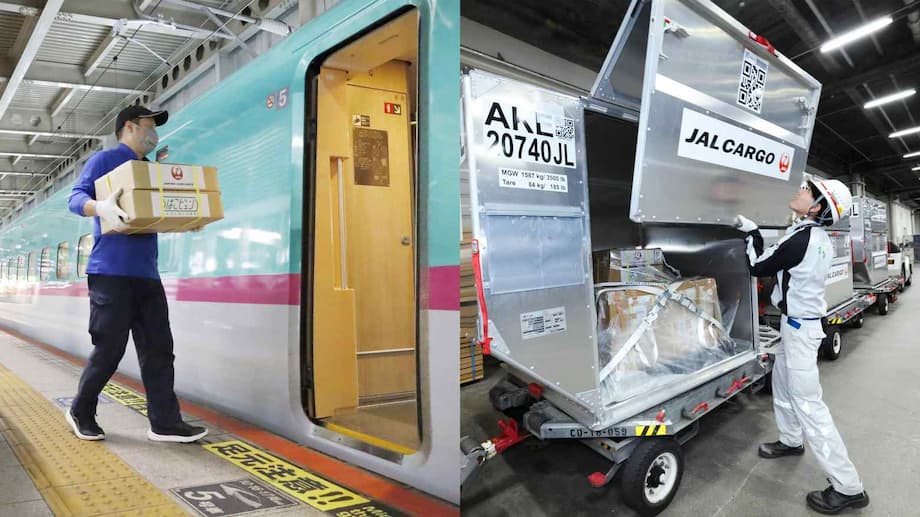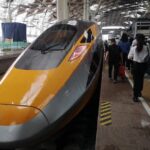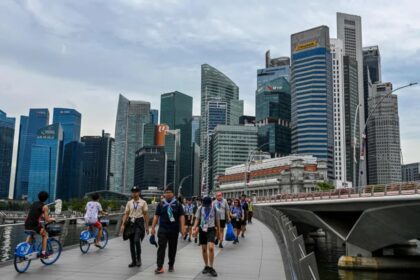A new fast lane for Japanese products bound for Singapore
Japan’s shinkansen has begun carrying delicate cargo for export runs, with a pilot shipment of about 300 carefully packed packages headed to Singapore. Railway operators coordinated a rail-to-air chain that used a bullet train leg inside Japan, then a flight to Changi. The result, according to organizers of the trial, was a roughly 20 percent cut in end to end transport time compared with the standard route that relies on long truck hauls to the airport before takeoff. Faster handoffs, smoother rides, and minute by minute punctuality helped shave hours from a schedule where freshness matters.
- A new fast lane for Japanese products bound for Singapore
- How the route works from farm to Singapore
- From pandemic experiment to a new business line
- Cargo only shinkansen cars under consideration
- Concerns and competition inside rail
- Why Singapore is the testbed
- The strengths and limits of shinkansen for goods
- What the time saving means for exporters and buyers
- What could come next
- Key Points
The test builds on a practice that emerged during the pandemic, when shinkansen cars with empty seats began carrying parcels on selected runs. It now fits a bigger push to ease pressure on Japan’s logistics system as trucking faces a shortage of drivers under tighter overtime rules that began in April 2024. Railway companies are turning the country’s most reliable passenger network into a rapid land bridge for high value goods, linking regional producers to international flights on the same day.
What moved on the train
The pilot focused on compact, high value, and often perishable items that benefit most from a gentle, predictable ride. These include premium fruit, fresh seafood, confectionery, and medical supplies that must reach overseas buyers fast and in perfect condition. Such items can be strapped in and cushioned to avoid shocks, then transferred quickly at the airport to temperature controlled storage before being loaded on a flight to Singapore. The mix can change by season, but the logic is the same: the less time in transit and the fewer handoffs, the better the quality on arrival.
How the route works from farm to Singapore
The journey starts with local pickup near farms, fisheries, or small factories. A short road leg brings the freight to a shinkansen station. Inside the train, space is prearranged so packages can be secured and kept stable. The rail run moves the cargo to the Tokyo area at sustained high speed, then staff hand off to an airline cargo team for the flight to Singapore. This approach avoids unpredictable highway congestion around the capital, an area known for bottlenecks that can easily add hours to a schedule.
On the Tokyo to Singapore sector, the air leg remains the fastest option, often arriving the same day or early the next morning depending on departure timing and customs processing. The win comes inside Japan, where rail leg reliability trims multiple hours compared with a long truck drive. Punctuality matters for exporters because it narrows the buffer they must build into a shipment plan, reducing the time products sit waiting at a cargo terminal. Less waiting and less handling raise the chances that produce and seafood reach Singapore kitchens at peak freshness.
Why choose rail over roads inside Japan
Speed, predictability, and a smoother ride distinguish the shinkansen for this task. Running at up to 320 kilometers per hour on dedicated tracks free of road traffic, bullet trains are insulated from weather and congestion that slow trucks. The system is famous for precision scheduling, with average delays measured in seconds to a minute. Vibration is also lower and more constant than on highways, an advantage for fragile fruit or desserts that do not tolerate bumps. Energy use per ton kilometer is favorable compared with long truck hauls, and stations are located in the heart of major cities, close to airline cargo terminals.
From pandemic experiment to a new business line
Railway groups began mixing passengers and cargo in 2020 when demand for travel collapsed. The practice has since matured, with organized loading at selected stations and time slots for quick transfers. East Japan Railway (JR East) has conducted regular operations on routes such as the Tohoku corridor, carrying items like fresh fish and regional specialties into the Tokyo market. The company says it intends to commercialize high speed, higher volume freight services in fiscal 2025, and trials are underway.
The idea is simple: if a small portion of a consist is dedicated to rapid cargo, or if some runs are designed for freight, the network can move more goods at passenger train speeds. That requires robust ground procedures at stations, clear booking systems, and tight coordination with airline partners. It also requires picking the right products. Exporters that ship premium seafood, fruit, sweets, pharmaceuticals, or urgent spare parts benefit most because every saved hour can protect quality and value.
Government and industry interest
Officials at the Land, Infrastructure, Transport and Tourism Ministry see high speed rail freight as one route to ease the strain from the 2024 trucking rules. A ministry study group has discussed cargo dedicated shinkansen concepts. It has also flagged a broader goal of doubling the amount of freight moved by rail over about the next decade. Analysts at Nomura Research Institute estimate potential daily demand for shinkansen moved freight in Japan at around 900 tons, describing a viable business if operators capture cargo that values speed and reliability. JR East has floated a medium term target of handling freight worth 10 billion yen once the service scales.
One senior official summed up the appeal of a frequent high speed cargo service.
Logistics will change completely if Shinkansen can transport cargo at high frequency.
Rail groups connected to JR East, such as JR Hokkaido, have also shown interest, citing the chance to move agricultural and seafood products from northern regions to Tokyo faster for export. The model could then extend to other corridors where schedules allow.
Cargo only shinkansen cars under consideration
JR East is studying a car design with seats removed so that only freight rides inside. Expanding door openings, installing anchor points for roll-in containers, and setting up the first car as cargo space are all on the table. The company has also weighed entire trains dedicated to cargo on certain paths, though that would depend on available slots in dense timetables and on market demand. Trials today still rely mainly on unoccupied spaces inside standard cars, a flexible method that works while volumes are modest.
Where room is tight, operators must protect the passenger experience. The Tokaido corridor, the busiest line in Japan, runs trains at very high frequency with top speeds around 285 kilometers per hour. Squeezing in slower or heavier formations can ripple through the schedule. That is one reason planners see more near term potential on lines with slightly more slack, such as the Tohoku or Kyushu corridors. Stations would need better loading bays and back rooms to stage cargo between platforms and trucks, along with equipment to quick freeze, chill, or maintain temperature if the service grows.
Balancing seats and freight
Turning passenger seats into cargo capacity reduces the number of tickets available, so railways will balance revenue from both sides. Some trains during off peak hours or late at night are better candidates for larger cargo blocks. Current luggage rules on many shinkansen lines already organize where oversized personal bags sit and how seats are reserved near luggage areas. Dedicated cargo cars would move this activity out of the passenger saloon entirely, improving comfort and making loading far more efficient.
Concerns and competition inside rail
Not everyone in the rail sector is enthusiastic about cargo shifted to bullet trains. JR Freight, the operator of conventional freight trains on the national network, worries that shinkansen services could peel away lucrative consignments. The company’s revenue base is much smaller than that of JR East, and spare capacity on its trains is limited. Its leadership has warned that aggressive shinkansen cargo growth could prompt a scramble for premium shipments rather than a coordinated logistics upgrade.
JR Freight President Shin Inukai has voiced a specific concern about demand migration to the bullet train network.
There is a fear that the demand for logistics will shift to Shinkansen trains.
Rail operators say a practical split is possible. High volume, less time sensitive cargo such as building materials and bulk food can remain on conventional freight. Small, high value, and time critical consignments can use bullet trains to reach airports, then continue by air. This specialization would let each mode play to its strengths while giving shippers real choice.
Why Singapore is the testbed
Singapore’s dining scene and retail sector have a long appetite for premium Japanese produce and seafood. Chefs at top restaurants prize consistency, origin labeling, and pristine condition. Many items are seasonal and sell at auction or through specialty brokers that require rapid delivery. A faster, more predictable route from Japanese regions to Tokyo airports, then to Changi, creates a tighter window between harvest or landing and the dinner plate. That supports high standards and reduces waste.
Regional initiatives show how this can work. JR Kyushu has already delivered premium ingredients by shinkansen from Kagoshima and other areas for showcase events, then joined those rail legs with short flights. Organizers report that produce can reach destinations like Taiwan within half a day of harvest when schedules line up. A Fukuoka event brought chefs from top Singapore restaurants to experience Kyushu’s ingredients, underscoring how logistics innovation can broaden culinary exchange. The same model can serve Singapore on selected days, subject to flight slots and customs coordination.
The strengths and limits of shinkansen for goods
Japan’s bullet train network is built for speed, stability, and precision. Trains run up to 320 kilometers per hour on dedicated standard gauge tracks with automatic control systems that maintain safe spacing. The safety record is unmatched, with no passenger deaths from train accidents since service began in 1964. Reliability is also a hallmark. Trains operate on dense schedules with average delays typically under a minute. For cargo, that means exporters can plan to the minute and hit flight cutoffs with less buffer time.
There are limits. Station layouts were designed for passengers, not pallets. Elevators, corridors, and platform access must handle trolleys and containers without disrupting travelers. Heavy cargo can affect acceleration and braking, and in the busiest corridors any change to performance can cascade through the timetable. Using standard seats to carry goods is best as a bridge until dedicated cargo cars arrive. Packaging, shock absorption, and temperature control are also vital. Perishables often need insulated boxes with coolants and sensors, plus fast handoffs at stations and at the airport cargo terminal.
What the time saving means for exporters and buyers
Cutting end to end time by about 20 percent gives producers more margin to pick, pack, and ship without rushing. That reduces handling errors and can preserve shelf life. A fisherman in Kyushu, for example, can land a catch before dawn, hand it to a shipper that morning, and see it in Singapore restaurants by the next day’s lunch service. Fruit growers can harvest at peak ripeness and still make a flight, rather than picking earlier to meet an uncertain truck schedule. For buyers in Singapore, the net effect is better consistency, fewer stockouts, and higher quality on the plate.
The model is not for every shipment. Bulk cargo, large appliances, and low value goods will remain on ships or conventional freight. The sweet spot is compact items whose value per kilogram is high and where freshness is central. As costs come down with scale and operations mature, the range of eligible products can expand. The rail to air chain also provides resilience during highway closures, typhoons, or peak holiday periods when trucking slots or driver hours are tight.
What could come next
The near term focus is on standardizing procedures, expanding station handling capability, and selecting corridors with room in the timetable. If cargo only cars enter service, loading doors can widen and floor plans can accommodate roll-in containers that speed up station stops. Some operators have discussed assigning the first car of a formation to cargo so passengers do not pass through it, improving security and comfort. Airline partnerships will remain central, since the international leg sets the longest time segment. The combination of shinkansen and air can also serve other hubs in Southeast Asia as demand grows.
On the policy side, the government’s aim to raise the share of rail in freight movement will guide investment decisions. Ports and oceans shipping are also expanding. Japan’s container carrier Ocean Network Express plans to spend heavily on new vessels and port upgrades by 2030, which shows how all links in the chain are scaling to meet demand. The rise of high speed rail freight adds a flexible option for shippers, especially those serving premium markets like Singapore where quality commands a price.
Key Points
- Shinkansen to air chain cut Japan to Singapore transport time for select goods by roughly 20 percent in a pilot run.
- About 300 compact, high value packages rode the train before being transferred to a flight to Changi.
- Rail operators began carrying cargo on bullet trains during the pandemic and are now moving toward commercial services.
- JR East is studying cargo only cars, larger doors, and possibly full formations for freight, with fiscal 2025 targeted for commercialization.
- A ministry study group has highlighted rail’s role in easing the 2024 trucking labor crunch and aims to double rail freight over about 10 years.
- Analysts estimate potential demand for shinkansen moved freight at around 900 tons per day nationwide.
- JR Freight has warned that demand might shift from conventional freight to bullet trains, calling for careful coordination.
- The Tokaido corridor’s tight timetable limits near term cargo paths, so other lines like Tohoku and Kyushu may see earlier growth.
- Kyushu trials show premium food can reach regional hubs in Asia within half a day, and Singapore’s market is a prime target for freshness sensitive products.












